
Juliette Sturlèse The Night Will Tell Us
Leipzig 10 Jun – 27 Aug 2022
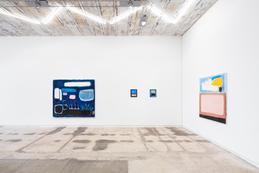
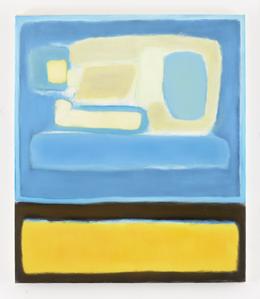
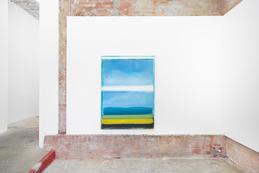
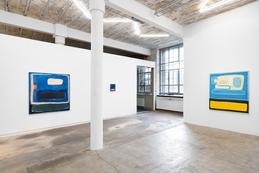
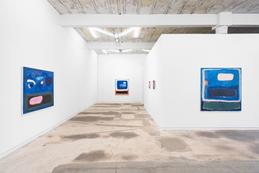
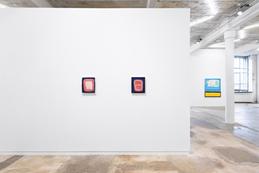
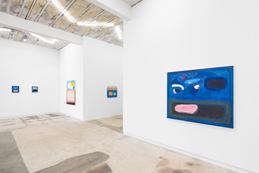
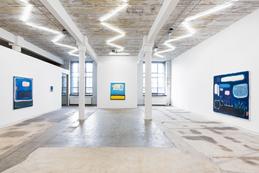
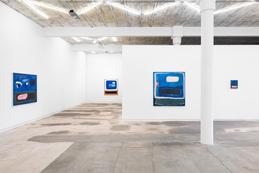
I AM HERE
„Nothing that we use, hear or touch can be expressed as good in words as the senses perceive it“
— Hannah Arendt, philosopher and political scientist, 1906–1975
Juliette Sturlèse’s gaze extends beyond the canvas, into the distance, onto fields and lakes, across landscapes and seas. Her abstract figuration not only manifests people and landscapes, but also describes memories, expresses longings. Through the pictures the past and the future are brought into the now and made visible. Through the colors the essence of the moment is transported to the viewers’ retinas. The expansive sceneries redeem promises of freedom which break out of the four walls of the everyday. Sturlèse perceives her environment with all her senses and powerfully visualizes the immanent emotions which smells, light or human encounters and conflicts awaken in her. Similar to the writer Marcel Proust, an important attachment figure for the painter who with In Search of Lost Time (1) devoted a seven-part novel to memory, Sturlèse creates a visual collection of countless personal impressions with her work.
Her pictures can be seen as reflections on life. Sometimes they are imbued with the gentle light of the south of France, at others the raw beauty of England. Sturlèse moves between the two locations and captures their respective energy. The translation of the experiences into painting is also an attempt to resist digitalization. As early as 1840 the painter Paul Delaroche already announced the “Death of Painting”(2) after seeing one of the first photographs. As it is, the monstrous flood of images we are exposed to on a daily basis appears vulgar in comparison to the immediacy of painting. It is precisely the longing for poesy, the desire for the vital surface and the engaging haptics of materiality that lends the art of painting its vigor.
In Sturlèse’s studio I am embraced by the luminous colors and the two-dimensional hue. I immediately begin to draw references to the representational in the supposedly abstract pictures, discover trees and figures, mountains and fields. But I am also imminently aware that it is my own experiences and points of reference that lead to these observations. What connections do other viewers draw?
The new group of works appears to be symbolic of inside and outside. The brightness of day is juxtaposed to the darkness of night, the visibility of the external is contrasted with the inner world of feelings. For Sturlèse, the author of the pictures, the canvas provides the necessary security to give room to both states. Every single grain of pigment is combined, like the words in a story, to form a pictorial construct. Landscapes and sceneries are carefully built up, held together by oil or bee’s wax as binding agent. In contrast to conventional painting materials, the wax does not mix the individual pigments, instead it places them next to and on top of one another. Like visible electrons around the nucleus they circle around, repel and attract each other; the intensity of every individual particle of color remains visible in its own right. For the painter her time in the studio is a part of life. Her life is painting. The urge to create, to explore, to despair of the material and to fail with a subject is an essential component of the metaphysical spirituality which an engagement with the medium holds in store.
Above all, the pictures give expression to the transience of the moment. The desire to capture the instant, permanently smoldering inside the painter, is manifested on the canvas. “I'm trying to remember what I felt about a certain cypress tree and I feel if I remember it, it will last me quite a long life,“(3) explained the artist Joan Mitchell. Sturlèse not only attempts to remember, but reflect that which she has perceived back to her environment. The painter generously provides us with access to her deepest inner world, shares her recordings with us, and calls on us to do the same with the help of her pictures.
Text by Nicola Petek
(1) Original French title: À la recherche du temps perdu, published between 1913 and 1927. Cf. PROUST, Marcel: In Search of Lost Time, the Modern Library edition in six volumes, New York, 2003.
(2) Cf. STIEGLER, Bernd: Theoriegeschichte der Photographie, Ann Arbor 2006, p. 404.
(3) LIVINGSTONE, Jane (ed.): The Paintings of Joan Mitchell, San Francisco 2002, p. 26.
„Nothing that we use, hear or touch can be expressed as good in words as the senses perceive it“
— Hannah Arendt, philosopher and political scientist, 1906–1975
Juliette Sturlèse’s gaze extends beyond the canvas, into the distance, onto fields and lakes, across landscapes and seas. Her abstract figuration not only manifests people and landscapes, but also describes memories, expresses longings. Through the pictures the past and the future are brought into the now and made visible. Through the colors the essence of the moment is transported to the viewers’ retinas. The expansive sceneries redeem promises of freedom which break out of the four walls of the everyday. Sturlèse perceives her environment with all her senses and powerfully visualizes the immanent emotions which smells, light or human encounters and conflicts awaken in her. Similar to the writer Marcel Proust, an important attachment figure for the painter who with In Search of Lost Time (1) devoted a seven-part novel to memory, Sturlèse creates a visual collection of countless personal impressions with her work.
Her pictures can be seen as reflections on life. Sometimes they are imbued with the gentle light of the south of France, at others the raw beauty of England. Sturlèse moves between the two locations and captures their respective energy. The translation of the experiences into painting is also an attempt to resist digitalization. As early as 1840 the painter Paul Delaroche already announced the “Death of Painting”(2) after seeing one of the first photographs. As it is, the monstrous flood of images we are exposed to on a daily basis appears vulgar in comparison to the immediacy of painting. It is precisely the longing for poesy, the desire for the vital surface and the engaging haptics of materiality that lends the art of painting its vigor.
In Sturlèse’s studio I am embraced by the luminous colors and the two-dimensional hue. I immediately begin to draw references to the representational in the supposedly abstract pictures, discover trees and figures, mountains and fields. But I am also imminently aware that it is my own experiences and points of reference that lead to these observations. What connections do other viewers draw?
The new group of works appears to be symbolic of inside and outside. The brightness of day is juxtaposed to the darkness of night, the visibility of the external is contrasted with the inner world of feelings. For Sturlèse, the author of the pictures, the canvas provides the necessary security to give room to both states. Every single grain of pigment is combined, like the words in a story, to form a pictorial construct. Landscapes and sceneries are carefully built up, held together by oil or bee’s wax as binding agent. In contrast to conventional painting materials, the wax does not mix the individual pigments, instead it places them next to and on top of one another. Like visible electrons around the nucleus they circle around, repel and attract each other; the intensity of every individual particle of color remains visible in its own right. For the painter her time in the studio is a part of life. Her life is painting. The urge to create, to explore, to despair of the material and to fail with a subject is an essential component of the metaphysical spirituality which an engagement with the medium holds in store.
Above all, the pictures give expression to the transience of the moment. The desire to capture the instant, permanently smoldering inside the painter, is manifested on the canvas. “I'm trying to remember what I felt about a certain cypress tree and I feel if I remember it, it will last me quite a long life,“(3) explained the artist Joan Mitchell. Sturlèse not only attempts to remember, but reflect that which she has perceived back to her environment. The painter generously provides us with access to her deepest inner world, shares her recordings with us, and calls on us to do the same with the help of her pictures.
Text by Nicola Petek
(1) Original French title: À la recherche du temps perdu, published between 1913 and 1927. Cf. PROUST, Marcel: In Search of Lost Time, the Modern Library edition in six volumes, New York, 2003.
(2) Cf. STIEGLER, Bernd: Theoriegeschichte der Photographie, Ann Arbor 2006, p. 404.
(3) LIVINGSTONE, Jane (ed.): The Paintings of Joan Mitchell, San Francisco 2002, p. 26.
Artists